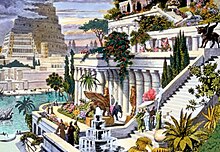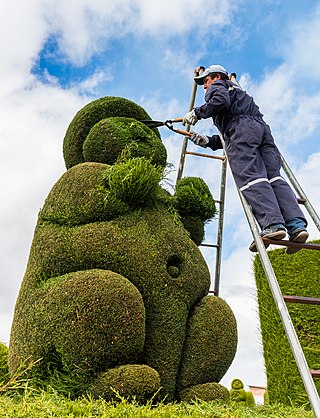
Gardening is the process of growing plants for their vegetables, fruits, flowers, herbs, and appearances within a designated space. Gardens fulfill a wide assortment of purposes, notably the production of aesthetically pleasing areas, medicines, cosmetics, dyes, foods, poisons, wildlife habitats, and saleable goods. People often partake in gardening for its therapeutic, health, educational, cultural, philosophical, environmental, and religious benefits.

The Hanging Gardens of Babylon were one of the Seven Wonders of the Ancient World listed by Hellenic culture. They were described as a remarkable feat of engineering with an ascending series of tiered gardens containing a wide variety of trees, shrubs, and vines, resembling a large green mountain constructed of mud bricks. It was said to have been built in the ancient city of Babylon, near present-day Hillah, Babil province, in Iraq. The Hanging Gardens' name is derived from the Greek word κρεμαστός, which has a broader meaning than the modern English word "hanging" and refers to trees being planted on a raised structure such as a terrace.
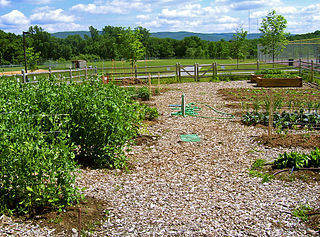
The following outline is provided as an overview of and topical guide to organic gardening and farming:

A roof garden is a garden on the roof of a building. Besides the decorative benefit, roof plantings may provide food, temperature control, hydrological benefits, architectural enhancement, habitats or corridors for wildlife, recreational opportunities, and in large scale it may even have ecological benefits. The practice of cultivating food on the rooftop of buildings is sometimes referred to as rooftop farming. Rooftop farming is usually done using green roof, hydroponics, aeroponics or air-dynaponics systems or container gardens.

Urban agriculture refers to various practices of cultivating, processing, and distributing food in urban areas. The term also applies to the area activities of animal husbandry, aquaculture, beekeeping, and horticulture in an urban context. Urban agriculture is distinguished from peri-urban agriculture, which takes place in rural areas at the edge of suburbs.

Container gardening or pot gardening/farming is the practice of growing plants, including edible plants, exclusively in containers instead of planting them in the ground. A container in gardening is a small, enclosed and usually portable object used for displaying live flowers or plants. It may take the form of a pot, box, tub, basket, tin, barrel or hanging basket.

A community garden is a piece of land gardened or cultivated by a group of people individually or collectively. Normally in community gardens, the land is divided into individual plots. Each individual gardener is responsible for their own plot and the yielding or the production of which belongs to the individual. In collective gardens the piece of land is not divided. A group of people cultivate it together and the harvest belongs to all participants. Around the world, community gardens exist in various forms, it can be located in the proximity of neighborhoods or on balconies and rooftops. Its size can vary greatly from one to another.
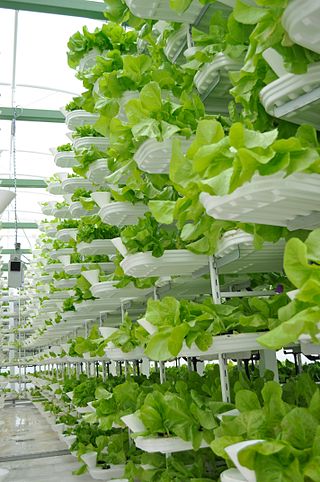
Vertical farming is the practice of growing crops in vertically and horizontally stacked layers. It often incorporates controlled-environment agriculture, which aims to optimize plant growth, and soilless farming techniques such as hydroponics, aquaponics, and aeroponics. Some common choices of structures to house vertical farming systems include buildings, shipping containers, underground tunnels, and abandoned mine shafts.
This is an alphabetical index of articles related to gardening.

A monastic garden was used by many people and for multiple purposes. Medieval gardens were an important source of food for households, but also encompassed orchards, cemeteries and pleasure gardens, as well as providing plants for medicinal and cultural uses. For monasteries, gardens were sometimes important in supplying the monks' livelihoods, primarily because many of the plants had multiple uses: for instance, peaches were used for closing wounds.

Urban horticulture is the science and study of the growing plants in an urban environment. It focuses on the functional use of horticulture so as to maintain and improve the surrounding urban area. Urban horticulture has seen an increase in attention with the global trend of urbanization and works to study the harvest, aesthetic, architectural, recreational and psychological purposes and effects of plants in urban environments.

Tecomaria capensis, the Cape honeysuckle, is a species of flowering plant in the family Bignoniaceae, native to southern Africa. Despite its common name, it is not closely related to the true honeysuckle.

Patrick Blanc is a French botanist who works at the French National Centre for Scientific Research, where he specializes in plants from tropical forests. He is the modern innovator of the green wall, specifically, he invented the modern vertical hydroponics garden, which distinguishes it from its predecessors.

Russelia equisetiformis, the fountainbush, firecracker plant, coral plant, coral fountain, coralblow or fountain plant, is a species of flowering plant in the family Plantaginaceae.
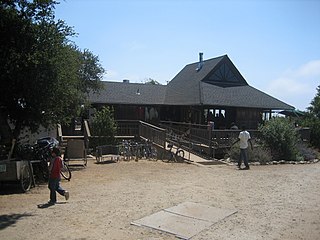
The UC Santa CruzCenter for Agroecology is a research, education, and public service organization within the Division of Social Sciences at the University of California, Santa Cruz.
Building-integrated agriculture (BIA) is the practice of locating high-performance hydroponic greenhouse farming systems on and in mixed-use buildings to exploit synergies between the built environment and agriculture.
There are many ways to garden in restricted spaces. Often a small or limited space is an issue in growing and cultivating plants. Restricted space gardens can be located on small lawns, balconies, patios, porches, rooftops, inside the home, or in any other available place. Gardening in small places can be applied to edible or floral plants. Growing food has many benefits including saving money; healthier, fresher, and better tasting food; knowledge of pesticide and fertilizer exposure. Gardening is a good form of exercise and has been proven to be therapeutic.

This is a history of notable hydroculture phenomena. Ancient hydroculture proposed sites and modern revolutionary works are mentioned. Included in this history are all forms of aquatic and semi-aquatic based horticulture that focus on flora: aquatic gardening, semi-aquatic crop farming, hydroponics, aquaponics, passive hydroponics, and modern aeroponics.

Foodscaping is a modern term for integrating edible plants into ornamental landscapes. It is also referred to as edible landscaping and has been described as a crossbreed between landscaping and farming. As an ideology, foodscaping aims to show that edible plants are not only consumable but can also be appreciated for their aesthetic qualities. Foodscaping spaces are seen as multi-functional landscapes that are visually attractive and also provide edible returns. Foodscaping is a method of providing fresh food affordably and sustainably.
Urban agriculture is the practice of cultivating, processing, and distributing food in or around urban areas. It is the growing of fresh produce within the city for individual, communal, or commercial purposes in cities in both developed and developing countries.
